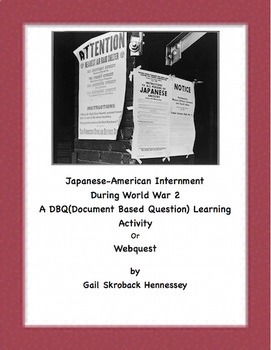DBQ: Life of a Japanese-American Child Living in an Internment Camp during WW2)
- PDF
- Webquests
Description
Using PRIMARY Sources in the Classroom. A DBQ activity uses primary sources. Sources can include diaries,posters, music, news articles from the time, anything written by those who participated in or witnessed an event in history. Students review the given documents and use many cognitive skills in processing what they see and read. After gathering information using the documents, students develop an essay answering a question.
The topic of this Primary Source(DBQ )is Life of a Japanese-American Child Living in an Internment Camp during World War 2.
A teacher page includes the Key,additional links and suggestions for a rubric to grade the DBQ.
This resource could also be used as a web quest.
Grades 5 and up
Check out my other DBQ Activity: Life on the Homefront During WW2:
Life on the Homefront during WW2
Also of Possible Interest:
During WW2, it was very unusual for a woman to be a pilot. When there was a shortage of male pilots due to their being needed in combat, an experimental project was begun where female pilots would be used by the military(although they weren't part of the military) to assist with ferrying aircrafts from the manufacturers to military bases. Female pilots, WomenAir Force Service Pilots,(WASP) also would test repaired planes to see if they were SAFE for male pilots to fly. They also were asked to help train soldiers by towing targets behind their airplane for the soldiers to shoot at(with REAL ammunition). Out of the 1074 WASP, 38 would die(11 in training missions). After the war, these heroic women were basically forgotten. In fact, what they did was classified. They could not call themselves "veterans", nor did they qualify for any military benefits. This wouldn't change until 1977. This play covers what it was like for a female member of the WASP and how their contributions were ignored but eventually honored for all that they did during World War 2. Great for Women's History Month, study on World War 2 or for a substitute or day before a holiday when you wish to introduce kids to some areas of history in our country.
This Reader's Theater Script using a compilation of women to create Mildred Wallingford, a member of the WASP. Real members are also mentioned throughout the reading.
Part of my Ms. Bie Ografee Talk Show Series, students learn about this important contribution to the war effort as a "studio audience" asks questions of Ms. Bie Ografee's guest. A Did You Know? fun facts, comprehension questions, links to additional information, a teacher page with extension activities and the key are also included. https://www.teacherspayteachers.com/Product/World-War-2-Female-PilotsMembers-of-the-WASP-A-Readers-Theater-Script-43782


